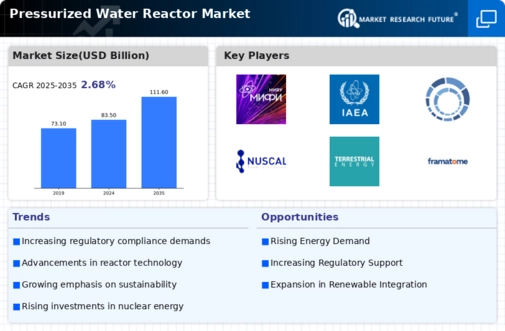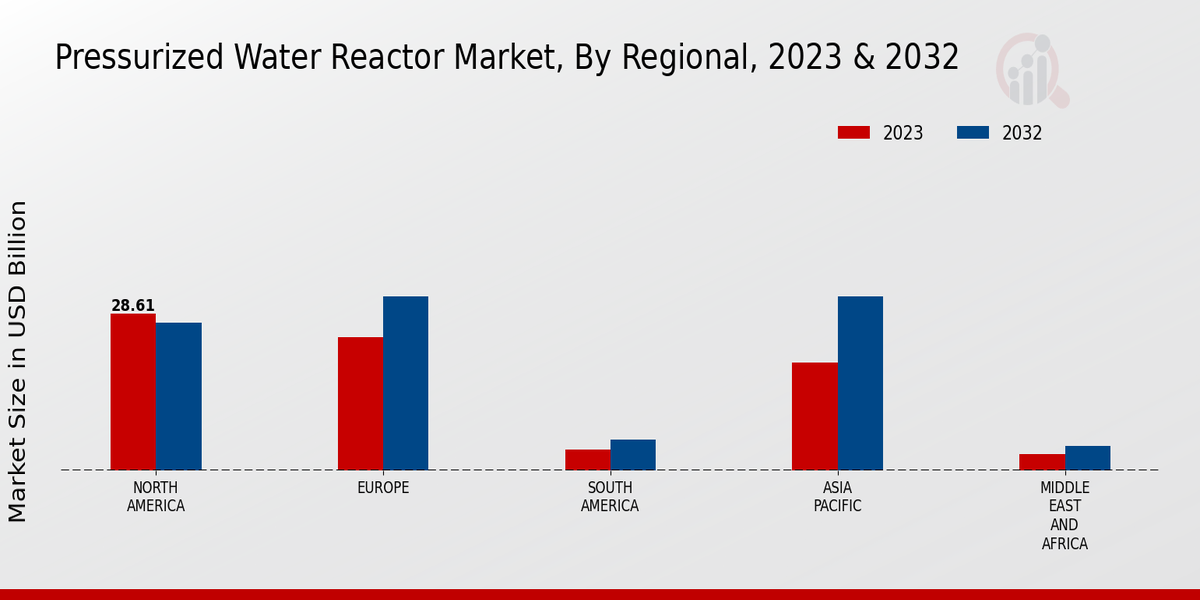Global Energy Security
Energy security remains a critical concern for many nations, influencing the Global Pressurized Water Reactor Market Industry. Countries are increasingly recognizing the importance of diversifying their energy portfolios to mitigate risks associated with reliance on fossil fuels. Nuclear energy, particularly through pressurized water reactors, offers a stable and reliable power source that can enhance energy independence. This strategic shift is evident as nations invest in nuclear infrastructure to ensure long-term energy security. The market's growth is anticipated to reflect this trend, as countries prioritize energy resilience in their energy policies.
Increasing Energy Demand
The Global Pressurized Water Reactor Market Industry is experiencing a surge in demand for energy due to population growth and industrialization. As countries strive to meet their energy needs, nuclear power emerges as a reliable source. In 2024, the market is valued at approximately 83.5 USD Billion, reflecting the growing reliance on nuclear energy. Nations are investing in new reactor designs and upgrades to existing facilities to enhance efficiency and output. This trend is expected to continue, with projections indicating a market growth to 111.6 USD Billion by 2035, driven by the need for sustainable and stable energy sources.
Technological Advancements
Technological innovations play a pivotal role in shaping the Global Pressurized Water Reactor Market Industry. Advancements in reactor design, safety systems, and operational efficiency are enhancing the appeal of pressurized water reactors. For instance, the development of Generation III and III+ reactors incorporates advanced safety features and improved fuel efficiency. These innovations not only reduce operational costs but also address safety concerns, which are paramount in nuclear energy. As a result, the market is poised for growth, with a projected CAGR of 2.68% from 2025 to 2035, indicating a robust future for technologically advanced nuclear solutions.
Market Trends and Projections
The Global Pressurized Water Reactor Market Industry is characterized by various trends and projections that indicate its future trajectory. The market is expected to grow from 83.5 USD Billion in 2024 to 111.6 USD Billion by 2035, reflecting a compound annual growth rate of 2.68% from 2025 to 2035. This growth is driven by increasing energy demands, technological advancements, and supportive government policies. Additionally, the focus on environmental sustainability and energy security further propels the market forward. These trends suggest a robust future for the pressurized water reactor segment within the broader nuclear energy landscape.
Government Policies and Regulations
Government policies and regulations significantly influence the Global Pressurized Water Reactor Market Industry. Many countries are implementing supportive frameworks to promote nuclear energy as a clean and reliable power source. This includes financial incentives, streamlined licensing processes, and enhanced safety regulations. For example, nations like France and China are actively expanding their nuclear fleets, supported by government initiatives. Such policies not only facilitate the construction of new reactors but also encourage the modernization of existing facilities. As a result, the market is expected to grow steadily, aligning with global energy transition goals.
Environmental Concerns and Sustainability
The Global Pressurized Water Reactor Market Industry is increasingly driven by environmental concerns and the push for sustainable energy solutions. As climate change becomes a pressing issue, nuclear energy is recognized for its low greenhouse gas emissions compared to fossil fuels. This awareness is prompting governments and industries to invest in nuclear technology as part of their strategies to reduce carbon footprints. The transition towards cleaner energy sources is likely to bolster the market, with projections indicating a growth trajectory that aligns with global sustainability goals. The emphasis on reducing reliance on carbon-intensive energy sources is a key factor in this evolving landscape.




















Leave a Comment